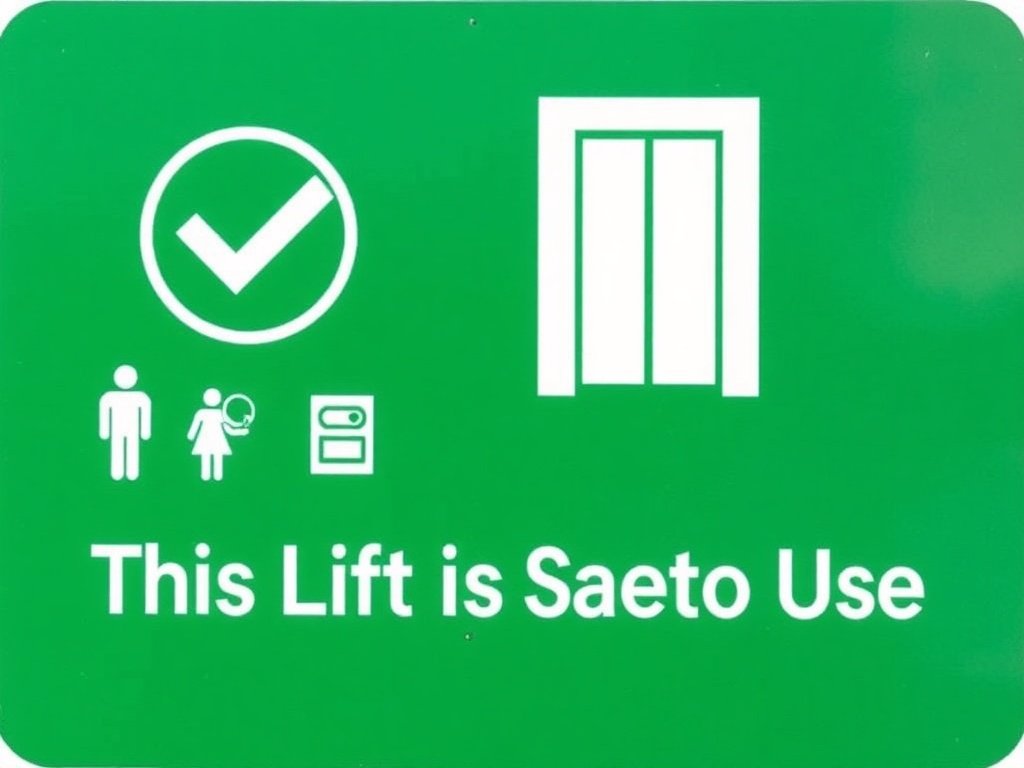
Understanding the Importance of Lift Safety Signs
In modern buildings, elevators (or lifts) are essential for accessibility and convenience. However, ensuring they are safe to use is not optional—it is a legal and moral responsibility. The sign that shows when a lift is safe to use is far more than a routine notice; it is a critical assurance backed by engineering inspections, government regulations, and international safety standards. Without proper certification and visible signage, passengers would be exposed to risks such as mechanical failure, entrapment, or even serious accidents. For this reason, every public and private facility must understand what these signs mean and why they matter.
What Does the Sign on a Lift Indicate?
When you step into a lift, you may notice a safety certificate or inspection notice displayed inside the cabin or near the entrance. This official document indicates that the elevator has been checked by certified engineers, has passed all safety protocols, and is deemed fit for daily operation. The sign generally includes:
- The date of the last inspection.
- The date of the next due inspection.
- The authority or agency responsible for testing.
- Unique lift identification and certification number.
This signage serves as a guarantee to users that the lift complies with strict safety measures and has no unresolved technical hazards.
Regulatory Standards Governing Lift Safety Signs
Every country has its own set of building codes and elevator safety regulations. For example, in the United States, ASME A17.1 and OSHA regulations mandate that elevators undergo routine inspections. In the European Union, EN 81 standards ensure compliance, while in countries like India and Singapore, state-level authorities enforce annual certification. Regardless of the region, the displayed sign or certificate must clearly show compliance. Failure to display this certificate can lead to fines, closure of the lift, and liability in case of accidents.
Why the Sign Is Non-Negotiable for Safety
Ignoring the presence of a lift inspection sign can be a costly mistake. A missing or expired certificate implies that the elevator may not have been inspected recently, leaving potential faults undetected. Building owners and managers have a legal duty of care toward occupants, meaning they can face lawsuits, insurance claim denials, or criminal negligence charges if an accident occurs due to a non-certified lift. The sign is not just paperwork—it is proof of accountability.
How Often Are Lifts Inspected?
The frequency of inspections depends on regional laws and the type of lift. Typically:
- Passenger lifts are inspected every 6–12 months.
- Freight elevators may require more frequent checks due to heavy load usage.
- High-rise building lifts often undergo advanced monitoring and quarterly inspections.
These inspections cover mechanical systems, emergency brakes, electrical wiring, communication devices, and door safety mechanisms. After passing, the updated inspection date is shown on the sign, confirming the lift’s safety.
Elements Found on a Lift Safety Certificate Sign
The certificate sign displayed in or near the lift often includes multiple details. Below is a breakdown in tabular form for clarity:
| Element | Purpose |
| Inspection Date | Confirms when the last official check was completed |
| Next Due Inspection Date | Alerts users and managers of upcoming deadlines |
| Certifying Authority | Displays the responsible government/agency body |
| Identification Number | Ensures traceability for compliance records |
| Emergency Contact | Provides quick reporting in case of malfunction |
Such transparency ensures that both users and administrators can easily verify the safety of the lift.
Visual Appearance of Lift Safety Signs
In most jurisdictions, the sign must be highly visible, laminated, and tamper-proof. It is usually displayed in the cabin above the control panel or at the entrance on each floor. Modern systems even include digital displays linked to centralized databases, allowing real-time verification of the certificate’s validity. By adopting digital signage, building managers can reduce fraud risks and make safety more accessible.
Consequences of Using a Lift Without a Valid Safety Sign
Using a lift that lacks a valid inspection sign can lead to serious consequences:
- Increased risk of mechanical breakdowns or accidents.
- Legal penalties, fines, and potential building closures.
- Negative impact on the reputation of property owners and managers.
- Loss of insurance coverage for accidents involving uncertified lifts.
Ultimately, the sign is not optional—it is a mandatory safeguard for everyone’s well-being.
The Role of Lift Engineers in Certification
Behind every displayed safety sign lies the work of professional lift engineers. These specialists test and certify elevators after conducting detailed evaluations, such as load testing, brake assessments, emergency system verification, and compliance with energy efficiency standards. Their role ensures that every lift is capable of safely transporting passengers and goods without risk.
User Awareness and Responsibility
While building owners carry the primary responsibility, users must also remain aware. If passengers notice an expired or missing inspection sign, they should avoid using the lift and immediately report it to management or building security. Public awareness is crucial because safety certifications are only effective if people recognize their importance.
Modern Technology Enhancing Lift Safety Signs
Technology has revolutionized the way lift safety signs function. Some buildings now utilize QR codes on lift certificates, allowing users to scan and instantly verify the authenticity of the inspection. Additionally, IoT (Internet of Things) sensors can feed live performance data to authorities, automatically updating the safety status displayed on the sign. This innovation ensures transparency and prevents fraudulent certifications.
International Case Studies of Lift Safety Compliance
Globally, there have been incidents where neglecting inspection signs caused tragedy. In countries with strict enforcement, accident rates are significantly lower. For example:
- Japan and Singapore maintain one of the lowest lift accident rates due to rigorous certification.
- Developing regions often face challenges where expired or missing signs contribute to frequent breakdowns and safety risks.
These cases highlight how crucial visible and updated safety signs are in reducing accidents worldwide.
Differences Between Passenger and Freight Lift Signage
Although the core principle remains the same, passenger lifts and freight lifts display slightly different safety certificates. Passenger lift signs focus on user safety, emergency systems, and comfort, whereas freight lift signs emphasize load capacity, mechanical durability, and operational limits. Both, however, must be prominently displayed and regularly updated.
How Building Managers Should Handle Lift Safety Signs
Building managers play a pivotal role in ensuring compliance. They must:
- Schedule inspections well before the expiration date.
- Keep maintenance logs accessible for auditing.
- Replace or update certificates immediately after each inspection.
- Train staff to identify expired or fraudulent signs.
This proactive approach ensures that lifts remain operational and safe without legal or operational setbacks.
Conclusion: Why You Should Always Check the Sign
The next time you step into a lift, pause for a moment and look for the inspection certificate sign. That small notice is a big assurance of your safety. It represents thorough inspections, legal compliance, and the dedication of engineers and building managers to protect lives. Without it, you should never trust the elevator. In short, the sign is not just a formality—it is your shield against unseen risks.
FAQs
1. Where is the lift safety sign usually displayed?
It is generally placed inside the cabin above the control panel or near the entrance to ensure visibility for all passengers.
2. What happens if a lift is used without a valid safety sign?
The risks include potential accidents, legal penalties, insurance claim denials, and severe liability for building owners.
3. Can I verify the authenticity of a lift safety certificate myself?
Yes, many modern certificates include QR codes or digital verification options that allow passengers to confirm validity instantly.





